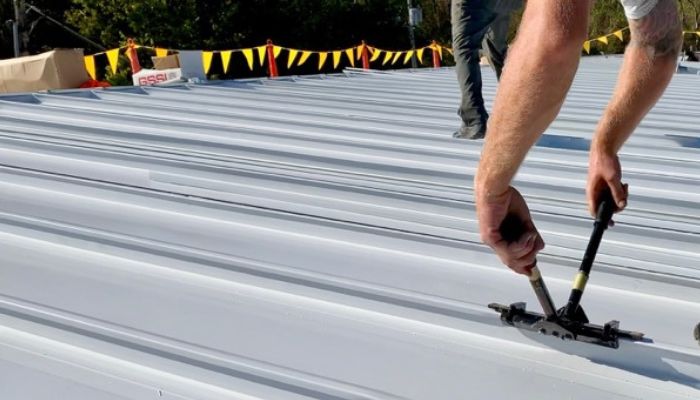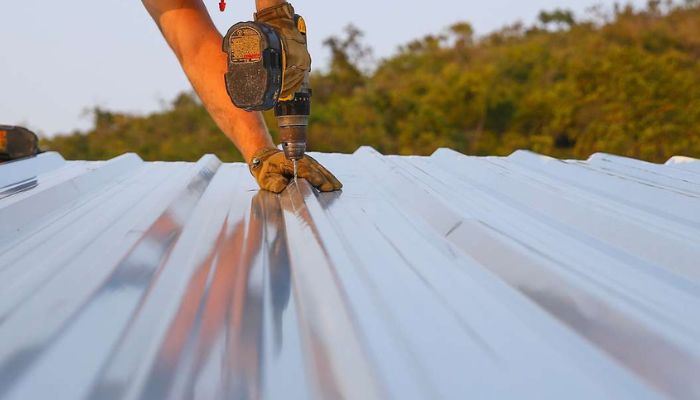How To Overlap Corrugated Metal Roofing ? - Roof Repair Services
- Home
- How To Overlap Corrugated Metal Roofing ?
Car Repairing

- January 6, 2024
- By: roofrepair_admin
- General
- Comments: 0
How To Overlap Corrugated Metal Roofing ?
Understanding the basics of corrugated metal roofing installation, particularly the overlapping technique, is crucial for a successful corrugated panels roofing project. This introduces the key concepts of corrugated metal roofing, highlighting its benefits and the importance of proper installation techniques, especially overlapping, to ensure durability and weather resistance.
Key Takeaways: Mastering Corrugated Metal Roof Overlapping
- Precision in Overlapping: Accurate overlapping is critical for the effectiveness and longevity of corrugated metal roofing.
- Proper Tools and Techniques: Using the right tools and following correct overlapping techniques ensure a watertight and durable roof.
- Attention to Detail: Paying close attention to details, especially around roof features and edges, is crucial for a successful installation.
- Regular Inspections and Maintenance: Routine checks and maintenance of overlapped areas are essential for sustaining roof integrity.
- Handling Repairs Promptly: Addressing repairs and replacements in overlapped sections promptly can prevent larger issues.
- Adapting to Environmental Factors: Consider local climate and environmental factors when overlapping corrugated metal roofing for optimal performance.
- Enhancing Roof Performance: Additional treatments like protective coatings can further enhance the roof’s durability and efficiency.
Preparing the Roof for Installation
Proper preparation of the roof surface is key to a successful installation. This section will guide you through the steps to prepare your roof for corrugated metal panels. We’ll cover cleaning the roof surface, removing old roofing materials if necessary, and ensuring the entire roof and structure is sound and ready for the new installation.
Understanding Corrugated Panel Profiles
Corrugated metal roofing comes in various profiles, each requiring specific overlapping techniques to install. This part will explain how to identify different corrugated metal roofs’ panel profiles and their unique installation requirements. We’ll provide a guide on measuring and cutting panels to fit your roof’s dimensions accurately.
Basic Overlapping Techniques

The core of this section focuses on the basic techniques of overlapping the corrugated metal sheets and roofing sheets. We’ll cover how to determine the appropriate amount of overlap for different panel types, the direction of overlap to ensure water runoff, and the method of aligning panels correctly. This includes step-by-step instructions on laying the first panel and subsequent panels to achieve optimal overlap.
Detailed Overlapping Strategies for Optimal Weatherproofing
Building on the basic techniques, this section delves into more advanced strategies for overlapping corrugated metal roofing. We’ll explore how to achieve optimal weatherproofing through precise overlapping, considering factors like local climate, roof pitch, and exposure to elements. This includes techniques for ensuring tight seals at overlaps to prevent leaks and water damage.
Handling Overlaps at Roof Features and Penetrations
Roof features such as vents, chimneys, and skylights pose unique challenges in overlapping corrugated metal panels. This part provides detailed guidance on how to manage overlaps around these features. We’ll discuss custom cutting and fitting panels, using flashing and sealants effectively, and ensuring that overlaps maintain the integrity of the roof’s own waterproofing material and barrier.
Securing Overlapped Panels: Fastening Techniques
Proper fastening of overlapped panels is crucial for the stability and longevity of the corrugated metal roofing sheets. This section covers the various fastening techniques suitable for the corrugated sheet metal roofing. We’ll discuss the types of fasteners to use, the correct placement and spacing of fasteners in overlapped areas, and tips for ensuring a secure and durable installation.
Addressing Expansion and Contraction in Metal Roofing

Metal sheet roofing materials can expand and contract with temperature changes, which impacts how panels are overlapped. This part will explain how to accommodate for thermal expansion and contraction in the overlapping process of metal sheets. We’ll provide insights into designing overlaps that allow for movement without compromising the roof’s effectiveness.
Aesthetic Considerations in Overlapping
While functionality is paramount, the aesthetic aspect of a vertically overlapping top cannot be ignored. This section will discuss how to overlap corrugated metal panels in a way that is not only effective but also visually appealing. We’ll cover alignment, symmetry, and color considerations to ensure that the overlapped panels contribute to the roof’s overall aesthetic.
Troubleshooting Common Overlapping Issues

Even with careful planning, overlapping issues can arise during installation. This part of the second row of the guide will address common problems such as misalignment, improper sealing, and fastening errors. We’ll offer solutions and troubleshooting tips to rectify these issues and ensure a smooth installation process.
Completing the Overlapping Process
In this final phase of installation, ensuring that every aspect of the overlapping process has been meticulously executed is crucial. This section will guide you through the final steps to complete the overlapping of corrugated metal roofing. We’ll cover the importance of a comprehensive review of all overlapped areas, ensuring consistent alignment, proper fastening, and effective sealing across the entire two to install corrugated metal roofing panels.
Inspecting Overlaps for Quality Assurance
Post-installation, conducting a thorough inspection of the overlapped areas is essential for quality assurance. This part will provide tips on what to look for during inspection, including checking for gaps, misalignment, and potential weak points in the roofing. We’ll discuss how to identify and rectify any issues that could compromise the roof’s integrity.
Long-Term Maintenance of Overlapped Metal Roofing

To ensure the longevity of your corrugated metal roof, ongoing maintenance is key. This section will offer advice on maintaining overlapped and installing corrugated metal roofing, including routine inspections, cleaning recommendations, and addressing wear and tear. We’ll also discuss the importance of monitoring overlapped areas for signs of corrosion or sealant failure.
Addressing Repairs and Replacements
Over time, even well-installed metal roofs may require repairs or replacements in certain sections. This part will guide you on how to approach repairs, particularly in overlapped areas. We’ll cover how to safely remove and replace damaged panels, ensuring that new overlaps are as effective as the original installation.
Enhancing Roof Performance with Additional Treatments
To further enhance the performance and durability of your corrugated metal roof, additional treatments can be applied. This section explores options such as protective coatings, anti-rust treatments, and insulation enhancements. We’ll provide insights into selecting and applying these treatments to maximize the roof’s efficiency and lifespan.
Conclusion: The Importance of Precision in Metal Roof Overlapping
In conclusion, the process of overlapping corrugated metal roofing demands precision and attention to detail. From the initial stages of preparation and installation to long-term maintenance and repairs, each step plays a crucial role in ensuring the corrugated roof top’s effectiveness and durability. By adhering to best practices in overlapping corrugated roofing, homeowners and installers can ensure that the corrugated metal roof provides reliable protection and maintains its aesthetic appeal for years to come.
Q&A Section: Navigating Corrugated Metal Roof Overlapping
Q1: How much overlap is required for corrugated metal roofing?
A1: Typically, the corrugated roofing sheets and metal panels should overlap by at least one corrugation, but this length can vary based on the specific panel profile and manufacturer’s recommendations.
Q2: Can I overlap sheets of corrugated metal roofing vertically and horizontally?
A2: Yes, but corrugated sheets of metal roofing requires both vertical and horizontal overlapping to ensure complete coverage and water tightness.
Q3: How do I seal the overlaps to prevent leaks?
A3: Use recommended sealants and ensure all screws have proper fastening along the overlaps. Applying sealant tape or butyl tape under the overlaps can also help prevent leaks.
Q4: What are the common mistakes to avoid when overlapping corrugated metal roofing?
A4: Common mistakes include insufficient overlap, improper alignment, inadequate sealing, and incorrect fastener placement.
Q5: Should I hire a professional for overlapping corrugated or sheet metal roofing?
A5: While DIY installation first sheet top is possible, hiring a professional is advisable for complex roofs or if you lack experience, as precision is key in overlapping.
Q6: How do I handle overlapping around roof features like vents or chimneys?
A6: Custom cut the panels to fit around these features and ensure adequate sealing of trim and flashing to prevent water penetration.
